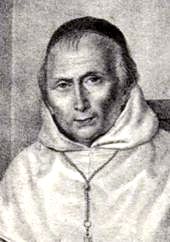Petrus Klausener
Petrus Klausener OSCO (French: Pierre Klausener ; * December 25, 1782 in Burtscheid ; † June 28, 1850 at the Oelenberg Abbey in Alsace ) was a German Trappist monk , also known as the Cistercian of the Stricter Observance, and abbot of Oelenberg Abbey.
Live and act
The son of the architect Franz Adolf Klausener (1739–1789) and Maria Christina Kühl on September 14, 1802, came from the strict Catholic Klausener family , whose members had become well known as architects in Burtscheit and neighboring Belgium as a novice in the Trappist monastery Kleinburlo near Darfeld in the community of Rosendahl in the district of Coesfeld . Three years later, on April 9, 1805 Klausener put the religious vows , and received a year later, on 20 September 1806 Münster Cathedral to Munster the priesthood .
The following years were extremely difficult for Klausen and the Trappist monks and nuns. Since the French Revolution of 1789, as a result of which the Trappist monks had fled France and found refuge in Rosendahl after a long odyssey in 1800 - the nuns in Rosendahl and the monks in the neighboring monastery Kleinburlo since 1804 - they were by the edict of July 24th 1811 again massively disadvantaged. This edict said that all Trappist monasteries in the entire sphere of influence of Napoleon should be abolished and the monks 'and nuns' assets should be confiscated. With a few exceptions, they then had to go to their respective home communities. After the collapse of French rule in 1814, they returned to Darfeld.
Subsequently, however, the new Prussian government also placed such high requirements on the monastery that regular religious life was extremely difficult to organize. For this reason, the incumbent abbot, Eugène La Prade, tried from 1815 to return the convents to France. After his death on June 16, 1816, Petrus Klausener was appointed prior of the double monastery Darfeld by Pope Pius VII in 1817 , as due to the political situation it was not possible to elect a proper abbot. It was now up to Klausener to coordinate further migration efforts.
After part of the men's convention under the leadership of Donatenmeister Bernard de Girmont had already moved to Entrammes in the canton of Laval-Est in 1815 and founded the Port-du-Salut monastery there on February 21, 1815 , Klausener also intensified his search for the Darfeld religious outside the Prussian sphere of influence. Finally, Alsace offered itself, where German was also spoken and the French king himself had just given the Trappists permission to return. It was not until the end of 1824 that a suitable property was found in Oelenberg in the community of Reiningue near Mulhouse in the French department of Haut-Rhin , the former monastery of the Augustinian Canons, which offered enough space for the nuns and monks who remained in Darfeld. In September 1825, the last 62 Darfeld Trappists (34 nuns and 28 monks) moved into the new Oelenberg monastery under their prior Klausener, which received papal confirmation on July 3, 1827. The monastery complex on the Rosenthal was then torn down in the same year.
After only four years of regular monastic life, the religious were expelled again as a result of the French July Revolution of 1830 . Along with the in Heinsberg originating Mother Superior of the nurse's home, Stanislaus (Maria Anna) Schey (1777-1848) and several other nuns and monks fled Klausener first in the former monastery Beinwil in the Swiss canton of Solothurn and a few months later to run , then still to Canton Belongs to Bern . After the situation in France had gradually calmed down, the religious returned to their Oelenberg monastery, which was finally elevated to an abbey in 1831 .
Then Peter Klausener was officially elected on 10 February 1832 the abbot and received on August 12, 1832 in Freiburg im Uechtland in the Swiss canton of Friborg by Bishop Pierre Tobie Yenni the benediction . Klausener died on June 28, 1850 after a long illness.
In his honor, a street in Rosendahl was named after Petrus Klausener.
Literature and Sources
- New Nekrolog der Deutschen Nr. 28 (1850); Pp. 945–948 (No. 264)
- Petrus Klausener in Biographia Cisterciensis , February 2011
Web links
- History of the Trappist monastery Rosenthal (PDF; 345 kB)
| personal data | |
|---|---|
| SURNAME | Klausener, Peter |
| ALTERNATIVE NAMES | Klausener, Pierre |
| BRIEF DESCRIPTION | German Trappist monk and abbot of Oelenberg Abbey |
| DATE OF BIRTH | December 25, 1782 |
| PLACE OF BIRTH | Burtscheid |
| DATE OF DEATH | June 28, 1850 |
| Place of death | Oelenberg |
